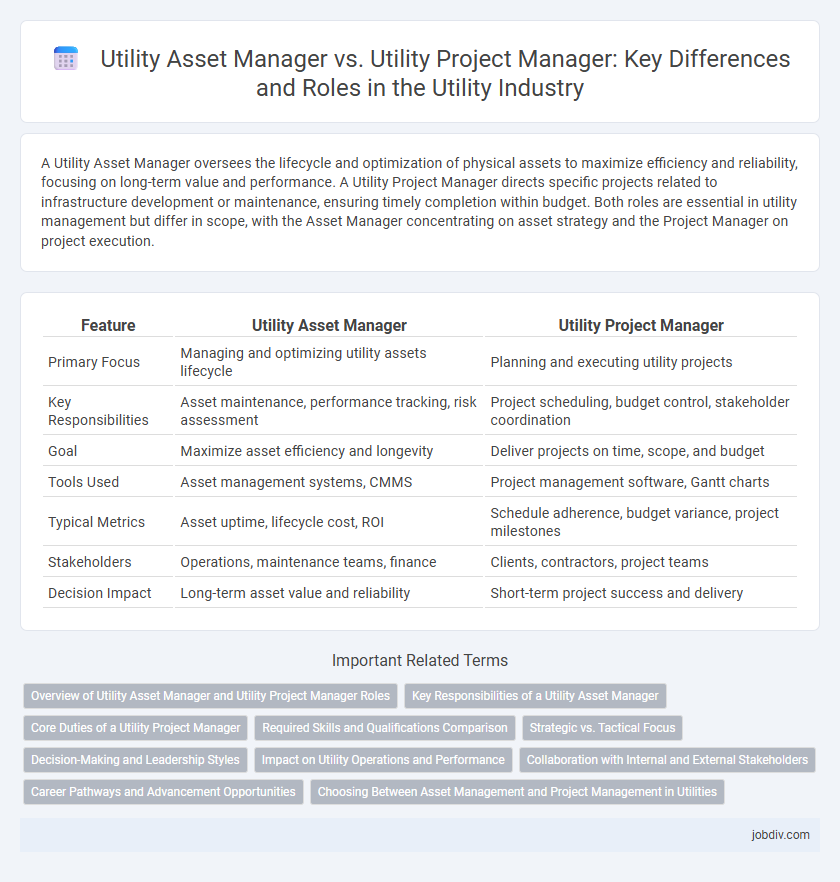A Utility Asset Manager oversees the lifecycle and optimization of physical assets to maximize efficiency and reliability, focusing on long-term value and performance. A Utility Project Manager directs specific projects related to infrastructure development or maintenance, ensuring timely completion within budget. Both roles are essential in utility management but differ in scope, with the Asset Manager concentrating on asset strategy and the Project Manager on project execution.
Table of Comparison
| Feature | Utility Asset Manager | Utility Project Manager |
|---|---|---|
| Primary Focus | Managing and optimizing utility assets lifecycle | Planning and executing utility projects |
| Key Responsibilities | Asset maintenance, performance tracking, risk assessment | Project scheduling, budget control, stakeholder coordination |
| Goal | Maximize asset efficiency and longevity | Deliver projects on time, scope, and budget |
| Tools Used | Asset management systems, CMMS | Project management software, Gantt charts |
| Typical Metrics | Asset uptime, lifecycle cost, ROI | Schedule adherence, budget variance, project milestones |
| Stakeholders | Operations, maintenance teams, finance | Clients, contractors, project teams |
| Decision Impact | Long-term asset value and reliability | Short-term project success and delivery |
Overview of Utility Asset Manager and Utility Project Manager Roles
Utility Asset Managers oversee the lifecycle management of infrastructure assets to maximize performance, reliability, and cost-efficiency, focusing on maintenance, risk assessment, and asset optimization. Utility Project Managers coordinate and deliver specific projects such as infrastructure upgrades or expansions, managing budgets, timelines, and stakeholder communication to ensure successful project execution. Both roles require deep industry knowledge but differ as Asset Managers emphasize long-term asset strategies while Project Managers prioritize the completion of discrete initiatives.
Key Responsibilities of a Utility Asset Manager
Utility Asset Managers oversee the lifecycle management of utility assets, including planning, acquisition, maintenance, and disposal to maximize asset value and reliability. They analyze asset performance data, develop maintenance strategies, and ensure compliance with regulatory standards to optimize operational efficiency and reduce costs. Their role includes coordinating with finance and engineering teams to prioritize capital investments and support strategic asset management plans.
Core Duties of a Utility Project Manager
The core duties of a Utility Project Manager include planning, executing, and closing utility infrastructure projects while ensuring compliance with regulatory standards and safety protocols. They coordinate cross-functional teams, manage budgets and timelines, and communicate with stakeholders to deliver projects on time and within scope. Unlike Utility Asset Managers, who focus on long-term asset performance and maintenance, Utility Project Managers drive the successful completion of discrete projects that enhance utility services.
Required Skills and Qualifications Comparison
Utility Asset Managers require strong expertise in asset lifecycle management, risk assessment, and regulatory compliance, with qualifications often including a degree in engineering or business and certifications like Certified Asset Manager (CAM). Utility Project Managers must excel in project planning, budgeting, and stakeholder communication, typically holding project management certifications such as PMP and experience in utility-specific infrastructure projects. Both roles demand proficiency in data analysis and ERP software, but Asset Managers focus more on long-term asset performance while Project Managers emphasize timely project delivery.
Strategic vs. Tactical Focus
Utility Asset Managers prioritize long-term strategic planning to optimize asset performance, lifecycle costs, and risk management across the utility's infrastructure. Utility Project Managers focus on tactical execution, ensuring projects are completed on time, within budget, and according to specifications. This distinction emphasizes the Asset Manager's role in driving sustainable value versus the Project Manager's responsibility for effective project delivery.
Decision-Making and Leadership Styles
Utility Asset Managers excel in strategic decision-making by prioritizing asset lifecycle optimization, risk management, and cost efficiency through data-driven insights. Utility Project Managers focus on operational decisions, emphasizing task delegation, timeline adherence, and resource coordination to ensure project delivery. Leadership styles differ as Asset Managers adopt transformational leadership to inspire long-term asset value, while Project Managers employ transactional leadership to drive immediate project outcomes.
Impact on Utility Operations and Performance
Utility Asset Managers optimize the lifecycle and reliability of physical assets such as transformers and pipelines, directly enhancing operational efficiency and reducing downtime. Utility Project Managers oversee infrastructure and technology projects, ensuring timely delivery and budget adherence, which significantly influences capacity expansion and system upgrades. Efficient collaboration between both roles drives improved utility performance, cost savings, and sustained service quality.
Collaboration with Internal and External Stakeholders
Utility Asset Managers coordinate closely with internal engineering teams and external contractors to optimize asset performance and lifecycle management. Utility Project Managers engage with cross-functional stakeholders, including regulatory bodies and community representatives, to ensure projects meet compliance and delivery timelines. Both roles require robust communication skills to align diverse stakeholder interests and achieve operational objectives efficiently.
Career Pathways and Advancement Opportunities
Utility Asset Managers focus on optimizing the lifecycle and performance of physical assets such as transformers, pipelines, and substations, often advancing into roles like Director of Asset Management or Chief Operations Officer by leveraging expertise in asset reliability and risk management. Utility Project Managers specialize in planning and executing infrastructure projects, with career progression leading to positions like Program Manager or VP of Project Development through demonstrated success in project delivery, budgeting, and stakeholder coordination. Both career pathways offer advancement opportunities, with asset management emphasizing strategic asset investment and project management centering on operational excellence and project portfolio governance.
Choosing Between Asset Management and Project Management in Utilities
Utility asset managers focus on optimizing the performance, lifecycle, and maintenance of physical utility infrastructure such as transformers, pipelines, and grid components to ensure reliability and cost efficiency. Utility project managers oversee the planning, execution, and completion of specific projects like infrastructure upgrades, expansions, or technology implementations, driving timelines and coordinating resources. Choosing between asset management and project management depends on whether the utility prioritizes long-term asset optimization or short-term project delivery for strategic growth and operational improvements.
Utility Asset Manager vs Utility Project Manager Infographic

 jobdiv.com
jobdiv.com